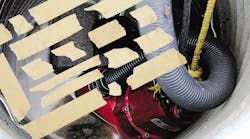A Cryptogram puzzle I was working on recently challenged readers to come up with 10 “adhesives” from given clues. I got nine of them—cement, glue, solder, etc. I finally got the last one by substituting known values from the other nine. As it turned out, the solution was “masking tape.”
I cried foul! You use masking tape to cover surfaces you don’t want to have painted. And although it can be used as an adhesive when you’re really desperate, it’s a lousy one. It has very low strength, does not stand up to moisture or extreme temperatures, and dries out over time, rendering it virtually useless.
If the authors wanted to include tape as an adhesive, they should’ve gone with one that’s actually used for adhering things together. We’ve all used duct tape to hold things together, at least temporarily. And transparent tape holds paper and other lightweight materials together almost invisibly when wrapping a gift. Several types of specialized tapes are also used as adhesives, such as carpet tape and surgical tape.
What, though, does this have to do with hydraulics? Well, just as masking tape is used differently from most other types of tape, hydraulic pumps are differently from most other types of pumps. In most cases, fluid exiting a pump’s discharge doesn’t find its way back into the pump. This is what sump pumps, process pumps, and even medical pumps do. But even circulating pumps have a different role from hydraulic pumps. Circulating pumps simply keep a fluid in a closed circuit moving. That’s all.
Instead, a hydraulic pump transmits mechanical power from its input shaft into fluid power in the hydraulic oil. From there, the hydraulic fluid flows through tubes, hoses, and valves to an actuator, which transmits the fluid power back into mechanical power for crushing, pressing, twisting, or turning. The more powerful the pump, the more powerful the mechanical work that can be done.
This is synonymous with how a generator transmits mechanical power from its input shaft into electrical power of moving electrons. The electrons then flow through wires, switches, and controls to a motor or solenoid, which converts the electrical energy back into mechanical power to rotate a shaft or shift a solenoid.
It’s this concept of converting mechanical power into fluid power that most people outside our industry haven’t grasped. They tend to group pumps all pumps together, so a hydraulic pump isn’t much different from all others, except the hydraulic pump is a bit beefier and only pumps hydraulic fluid. Maybe the authors of the cryptogram included masking tape because they didn’t grasp the concept of adhesives. More likely, though, I’ve over-analyzed all this.
I later thought there must be other types of tape that are not used as adhesives. Let’s see…recording tape, measuring tape, reflective tape, and one close to home for fluid power people: teflon tape! It won’t stick to anything.


